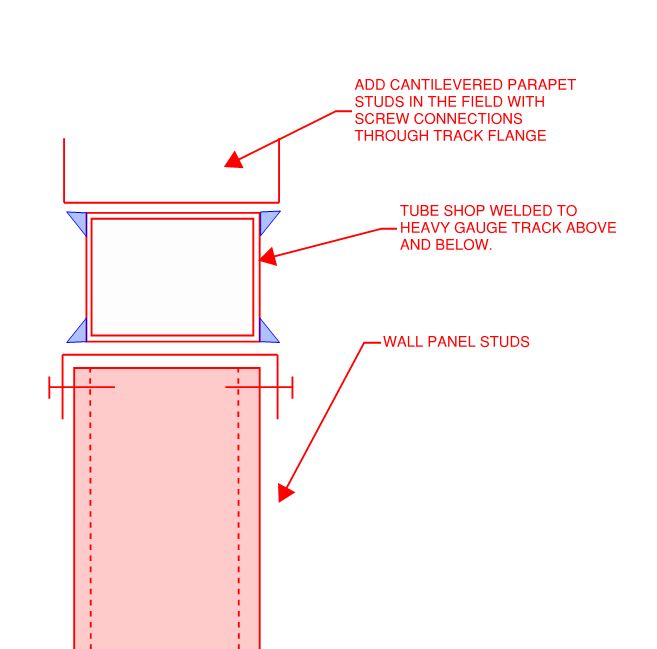Ron247
Structural
- Jan 18, 2019
- 1,128
I have a project with Cold-Formed Wall Studs and a bar joist roof setting on the walls. This is the first time I have used the 2 together on a project and would like any general guidance about connecting them. While I am very familiar with CFS on PEMBs, light gauge studs in general is not something I have done enough of in the past to get that gut instinct I like to have when designing. As with most designs, connecting different materials is more of a challenge. The roof live is 20 psf reducible and the roof dead load is less than 6 psf so I do not have massive loads.
I am not sure I can have a stud under every roof bar joist so I am intending to use a HSS section on the wall as I have seen others do. The following are some issues I have already spotted in doing a preliminary review of the architectural concept they have shown. Any guidance and advice will be appreciated.
[ul]
[li]One exterior wall has a parapet made by cantilevering the wall studs. I have seen mill steel shelf angles used on the inside face for the bar joist end seats to set on. What are the preferred methods of attaching these shelf angles such as welding, PAF etc? Is there a better method where something is attached between the studs for the end seat to set on?[/li]
[li]One wall has the top sloped to match the roof pitch of 1/4:12. Is setting the bar joist end seat on that slight of a slope an issue? Is it best to let the bar joint “twist” that amount or should the joist end seat be shimmed? I have never sat a bar joist on any slope that was perpendicular to the joist.[/li]
[li]If I use the roof panel as a diaphragm, what is a good way to transfer the shear from the last bar joist to the light gauge wall that runs parallel to it? That wall is a parapet also. I feel the mill angle is a little excessive for lateral load with a light vertical load.[/li]
[li]In attaching the HSS section to the CFS track, what are the preferred methods such as welding, PAF or self-drilling screws?[/li]
[li]What is the maximum end reaction you would allow on a heavy gauge track for 16” and 24” studs without using the HSS? I know a load can be calculated, but there are times people have maximums they use for reasons other than calcs.[/li]
[/ul]
As I stated, I am looking for some general guidance and common rules people use that deal with light gauge wall studs more than I do. Any generic details would also be appreciated especially if they show methods to connect the mill steel to light gauge steel.
Thanks in advance
I am not sure I can have a stud under every roof bar joist so I am intending to use a HSS section on the wall as I have seen others do. The following are some issues I have already spotted in doing a preliminary review of the architectural concept they have shown. Any guidance and advice will be appreciated.
[ul]
[li]One exterior wall has a parapet made by cantilevering the wall studs. I have seen mill steel shelf angles used on the inside face for the bar joist end seats to set on. What are the preferred methods of attaching these shelf angles such as welding, PAF etc? Is there a better method where something is attached between the studs for the end seat to set on?[/li]
[li]One wall has the top sloped to match the roof pitch of 1/4:12. Is setting the bar joist end seat on that slight of a slope an issue? Is it best to let the bar joint “twist” that amount or should the joist end seat be shimmed? I have never sat a bar joist on any slope that was perpendicular to the joist.[/li]
[li]If I use the roof panel as a diaphragm, what is a good way to transfer the shear from the last bar joist to the light gauge wall that runs parallel to it? That wall is a parapet also. I feel the mill angle is a little excessive for lateral load with a light vertical load.[/li]
[li]In attaching the HSS section to the CFS track, what are the preferred methods such as welding, PAF or self-drilling screws?[/li]
[li]What is the maximum end reaction you would allow on a heavy gauge track for 16” and 24” studs without using the HSS? I know a load can be calculated, but there are times people have maximums they use for reasons other than calcs.[/li]
[/ul]
As I stated, I am looking for some general guidance and common rules people use that deal with light gauge wall studs more than I do. Any generic details would also be appreciated especially if they show methods to connect the mill steel to light gauge steel.
Thanks in advance




